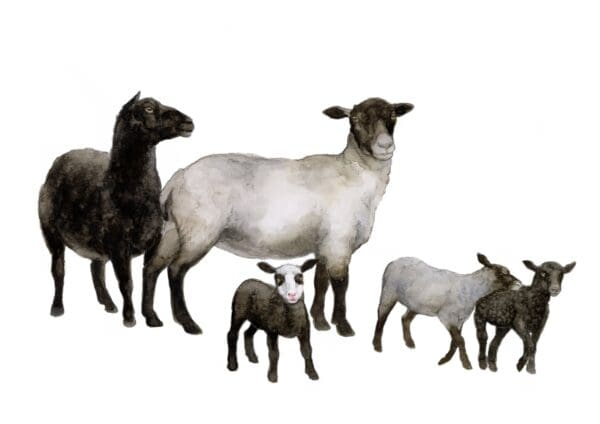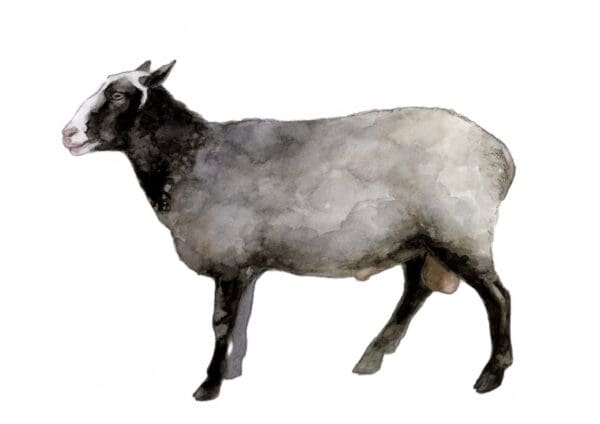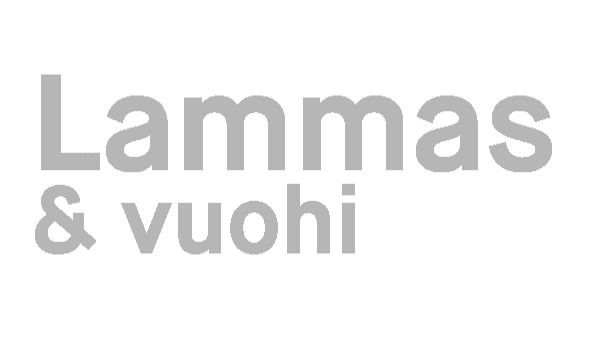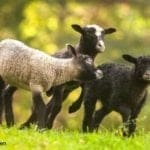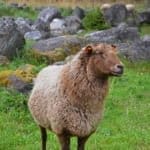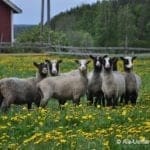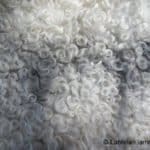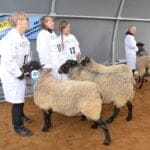Kainuu Grey

The Kainuu Grey breed belongs to the Northern European short-tailed breed group. It is a native Finnish breed well adapted to the local environment. Active revitalisation of the endangered grey landrace breed was started in the 1980s by Pertti Hankonen, and the Kainuu Grey was recognised as a distinct breed after DNA studies performed after year 2000. Animal recording data from the year 2023 accounts for 1 137 purebred lambed Kainuu Grey ewes. With more than one thousand ewes the breed is no longer considered endangered, but breeders still need to be careful to minimise inbreeding. The closest relatives of the Kainuu Grey are the Finnsheep and certain northwestern Russian breeds.
Variable appearance
The Kainuu Grey is a medium-sized breed; adult rams average 65 to 85 kg in weight, ewes 55 to 65 kg. Recording data from the year 2023 indicates an average 3.7 kg birth weight for lambs with an average daily growth of 190 g. Kainuu Grey sheep can be horned or polled. One typical breed characteristic is a violet tint to the skin and the tongue.
 The colour of Kainuu Grey wool varies from white to black, with various shades of grey in between. The most typical colour for adults is a light grey. Lambs are usually born nearly black; the wool begins to lighten at the age of a few months, with the adult colour reached at the age of one to two years. The smooth guard hair on the head and legs remains black. A small percentage of Kainuu Grey sheep are brown. In adults brown wool typically lightens to light grey or beige, with head and legs remaining darker brown. The breed standard for Kainuu Grey allows for white or black, all shades of grey and brown. Partially white guard hairs are also permitted.
The colour of Kainuu Grey wool varies from white to black, with various shades of grey in between. The most typical colour for adults is a light grey. Lambs are usually born nearly black; the wool begins to lighten at the age of a few months, with the adult colour reached at the age of one to two years. The smooth guard hair on the head and legs remains black. A small percentage of Kainuu Grey sheep are brown. In adults brown wool typically lightens to light grey or beige, with head and legs remaining darker brown. The breed standard for Kainuu Grey allows for white or black, all shades of grey and brown. Partially white guard hairs are also permitted.
Kainuu Grey wool consists of ground hair and guard hair. Both sexes sometimes have a dark back stripe composed of dark guard hair; rams can also have a dark mane.
Kainuu Grey sheep are unofficially divided into wool-type and fur type. The wool is mostly medium fine. Individual wool quality varies greatly, and even the same individual can have different types of wool. The best kind of Kainuu Grey wool has a pearlescent sheen to it. Fur-type wool is fluffy, with large curls.
A fertile and versatile breed
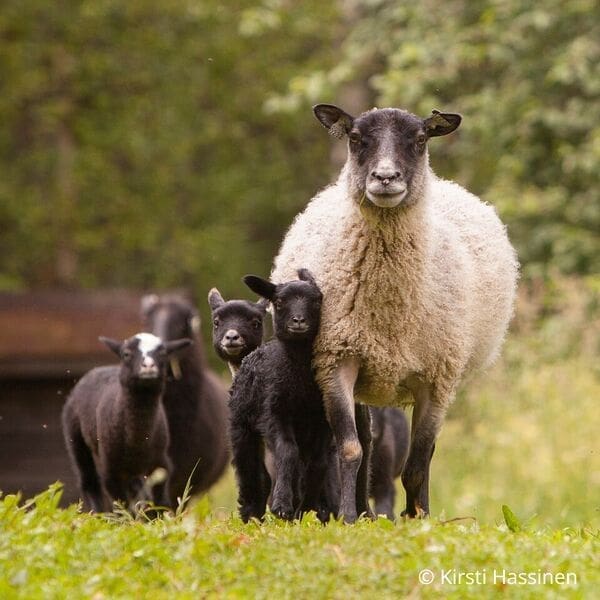 The Kainuu Grey is characterised as lively, curious, friendly and easy to handle. The breed’s fertility is excellent. Sexual maturity is reached early and ewes can be bred in all seasons. Estrus is typically intense, with most pregnancies resulting in multiple births. Recording data from the year 2023 indicates an average of 2,7 lambs born to ewes over two years old. Mothering ability and milk production are good, with recording data from 2023 indicating an average of 2,44 surviving lambs with an average total weight of 27,6 kg at four months of age.
The Kainuu Grey is characterised as lively, curious, friendly and easy to handle. The breed’s fertility is excellent. Sexual maturity is reached early and ewes can be bred in all seasons. Estrus is typically intense, with most pregnancies resulting in multiple births. Recording data from the year 2023 indicates an average of 2,7 lambs born to ewes over two years old. Mothering ability and milk production are good, with recording data from 2023 indicating an average of 2,44 surviving lambs with an average total weight of 27,6 kg at four months of age.
Slaughter characteristics are fair. Time to slaughter maturity varies from six months to nearly a year. Kainuu Grey sheep do not have a high tendency towards fattening and most of the fat is extramuscular, allowing it to be easily removed. Recent years have seen positive development in muscularity.
Kainuu Grey sheep are healthy and resilient, and are versatile in their possible uses. In addition to meat production, wool and pelts in different colors are valued especially for direct sale. The breed’s agility and relative lightness make it well suited for use in landscaping.
Breeding goals
The main goals in Kainuu Grey breeding are preservation of the breed itself, of its seven primary ram lines (A, I, L, M, P, R and T), its characteristic coloration and its good landscaping ability. Other goals include preservation of its good fertility and improvement of meat and wool quality to meet the demands of the industry and consumers. For this purpose, the following characteristics are monitored: fertility, mothering ability, growth rate, slaughter characteristics, health, build, the amount and quality of wool, and pelt quality.
The directives for the Kainuu Grey flock-book were approved in 2016.
Estimation of genetic diversity of the Kainuu Grey using pedigree data, Hannele Rissanen, 2017
Breeding guide for Kainuu Grey, Anna Silén, 2015
Breed features of Grey Finnsheep, Hannele Rissanen, 2011
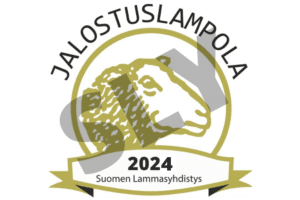 Qualified Breeding Farms 2024
Qualified Breeding Farms 2024
Pirjo and Hannu Iso-Junno, Kivipellon tila, email
Niina and Ismo Lohva, Lahtelan lammastila
Kokemäen koulutila, email
Helinä Leppänen, Noittaan tila
Click on the pictures to enlarge:
- Kainuunharmaskaritsat nauttivat kesästä
- T-linjan ruskea harmaspässi
- Kerityt uuhikaritsat pihalaitumella
- Harmastaljan kaunis kihara
- Harmasryhmä hurmasi Juvan pässinäyttelyssä syyskuussa 2017.
More information here >
